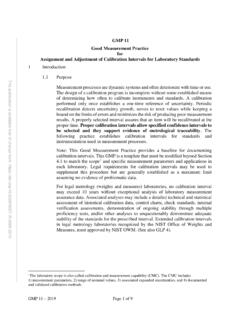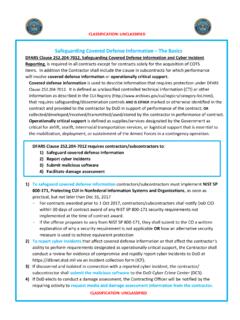Transcription of Transitioning the Use of Cryptographic Algorithms ... - NIST
1 NIST Special Publication 800-131A. Revision 2. Transitioning the Use of Cryptographic Algorithms and Key Lengths Elaine Barker Allen Roginsky This publication is available free of charge from: C O M P U T E R S E C U R I T Y. NIST Special Publication 800-131A. Revision 2. Transitioning the Use of Cryptographic Algorithms and Key Lengths Elaine Barker Allen Roginsky Computer Security Division Information Technology Laboratory This publication is available free of charge from: March 2019. Department of Commerce Wilbur L. Ross, Jr., Secretary National Institute of Standards and Technology Walter Copan, NIST Director and Under Secretary of Commerce for Standards and Technology Authority This publication has been developed by NIST in accordance with its statutory responsibilities under the Federal Information Security Modernization Act (FISMA) of 2014, 44 3551 et seq.
2 , Public Law ( ) 113-283. NIST is responsible for developing information security standards and guidelines, including minimum requirements for federal information systems, but such standards and guidelines shall not apply to national security systems without the express approval of appropriate federal officials exercising policy authority over such systems. This guideline is consistent with the requirements of the Office of Management and Budget (OMB) Circular A-130. Nothing in this publication should be taken to contradict the standards and guidelines made mandatory and binding on federal agencies by the Secretary of Commerce under statutory authority.
3 Nor should these guidelines be interpreted as altering or superseding the existing authorities of the Secretary of Commerce, Director of the OMB, or any other federal official. This publication may be used by nongovernmental organizations on a voluntary basis and is not subject to copyright in the United States. Attribution would, however, be appreciated by NIST. National Institute of Standards and Technology Special Publication 800-131A Revision 2. Natl. inst . Stand. Technol. Spec. Publ. 800-131A Rev. 2, 33 pages (March 2019). CODEN: NSPUE2. This publication is available free of charge from: Certain commercial entities, equipment, or materials may be identified in this document in order to describe an experimental procedure or concept adequately.
4 Such identification is not intended to imply recommendation or endorsement by NIST, nor is it intended to imply that the entities, materials, or equipment are necessarily the best available for the purpose. There may be references in this publication to other publications currently under development by NIST. in accordance with its assigned statutory responsibilities. The information in this publication, including concepts and methodologies, may be used by federal agencies even before the completion of such companion publications. Thus, until each publication is completed, current requirements, guidelines, and procedures, where they exist, remain operative.
5 For planning and transition purposes, federal agencies may wish to closely follow the development of these new publications by NIST. Organizations are encouraged to review all draft publications during public comment periods and provide feedback to NIST. Public All NIST period: comment ComputerMonth SecurityDay, Division YYYY publications, throughother than Day, Month the ones noted above, YYYY. are available at Comments on this publication may be submitted to: National Institute of Standards and Technology Attn: Computer Security Division, Information Technology Laboratory 100 Bureau Drive (Mail Stop 8930) Gaithersburg, MD 20899-8930.
6 Email: All comments are subject to release under the Freedom of Information Act (FOIA). NIST SP 800-131A REV. 2 Transitioning THE USE OF Cryptographic . Algorithms AND KEY LENGTHS. Reports on Computer Systems Technology The Information Technology Laboratory (ITL) at the National Institute of Standards and Technology (NIST) promotes the economy and public welfare by providing technical leadership for the Nation's measurement and standards infrastructure. ITL develops tests, test methods, reference data, proof of concept implementations, and technical analyses to advance the development and productive use of information technology.
7 ITL's responsibilities include the development of management, administrative, technical, and physical standards and guidelines for the cost-effective security and privacy of other than national security-related information in federal information systems. The Special Publication 800-series reports on ITL's research, guidelines, and outreach efforts in information system security, and its collaborative activities with industry, government, and This publication is available free of charge from: academic organizations. Abstract The National Institute of Standards and Technology (NIST) provides Cryptographic key management guidance for defining and implementing appropriate key management procedures, using Algorithms that adequately protect sensitive information, and planning ahead for possible changes in the use of cryptography because of algorithm breaks or the availability of more powerful computing techniques.
8 NIST Special Publication (SP) 800- 57, Part 1, Recommendation for Key Management: General, includes a general approach for Transitioning from one algorithm or key length to another. This Recommendation (SP. 800-131A) provides more specific guidance for transitions to the use of stronger Cryptographic keys and more robust Algorithms . Keywords Cryptographic algorithm; digital signatures; encryption; hash function; key agreement; key derivation functions; key management; key transport; key wrapping; message authentication codes; post-quantum Algorithms ; random number generation; security strength; transition.
9 Ii NIST SP 800-131A REV. 2 Transitioning THE USE OF Cryptographic . Algorithms AND KEY LENGTHS. Acknowledgments The authors would like to specifically acknowledge the assistance of the following NIST. employees in developing this revision of SP 800-131A: Lily Chen, Morris Dworkin, Sharon Keller, Kerry McKay, Andrew Regenscheid and Apostol Vassilev. This publication is available free of charge from: iii NIST SP 800-131A REV. 2 Transitioning THE USE OF Cryptographic . Algorithms AND KEY LENGTHS. Table of Contents 1 INTRODUCTION .. 1. Background and Purpose ..1. Useful Terms for Understanding this Recommendation.
10 2. Security Strengths .. 2. General Definitions and Abbreviations .. 3. Definition of Status Approval Terms .. 5. 2 ENCRYPTION AND DECRYPTION USING BLOCK CIPHER Algorithms .. 6. 3 DIGITAL SIGNATURES .. 8. This publication is available free of charge from: 4 RANDOM BIT GENERATION .. 11. 5 KEY AGREEMENT USING DIFFIE-HELLMAN AND MQV .. 12. 6 KEY AGREEMENT AND KEY TRANSPORT USING RSA .. 14. 7 KEY WRAPPING .. 15. 8 DERIVING ADDITIONAL KEYS FROM A Cryptographic KEY .. 16. 9 HASH FUNCTIONS .. 17. 10 MESSAGE AUTHENTICATION CODES (MACS) .. 19. APPENDIX A: REFERENCES .. 22. APPENDIX B: CHANGE HISTORY.
















